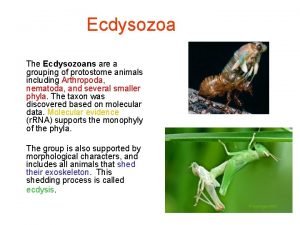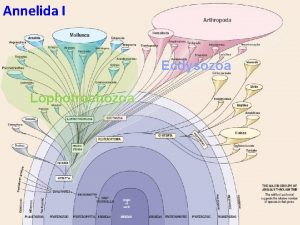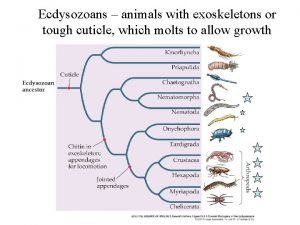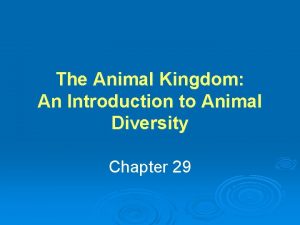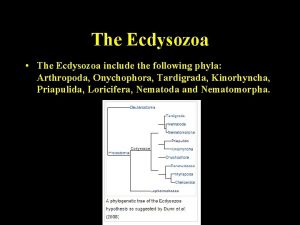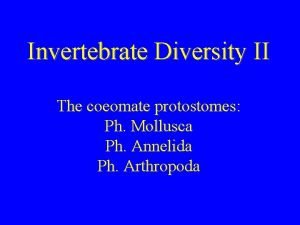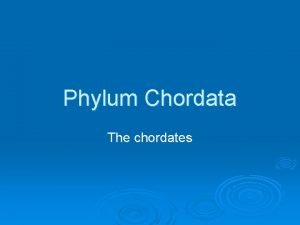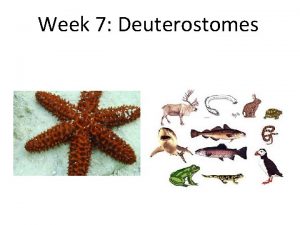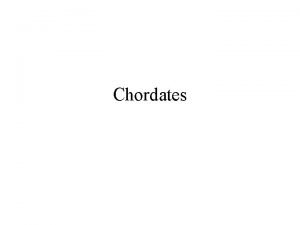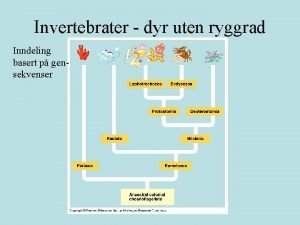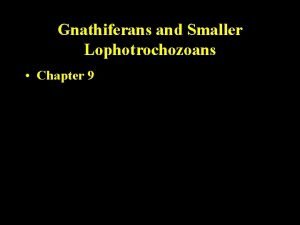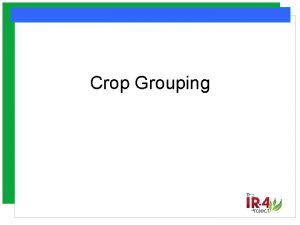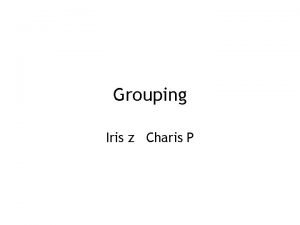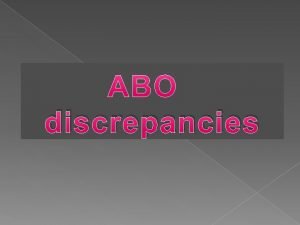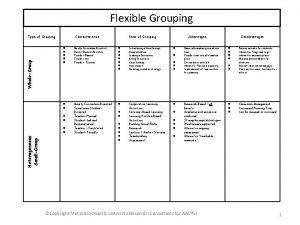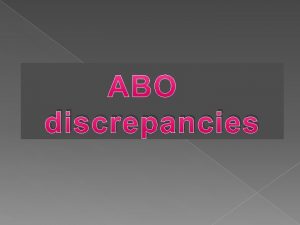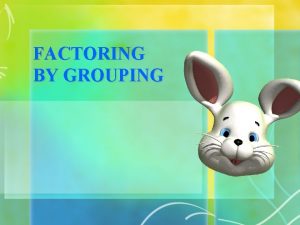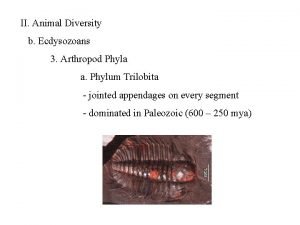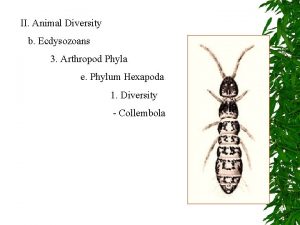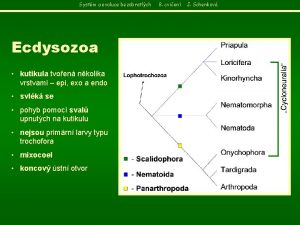Ecdysozoa The Ecdysozoans are a grouping of protostome









































- Slides: 41

Ecdysozoa The Ecdysozoans are a grouping of protostome animals including Arthropoda, nematoda, and several smaller phyla. The taxon was discovered based on molecular data. Molecular evidence (r. RNA) supports the monophyly of the phyla. The group is also supported by morphological characters, and includes all animals that shed their exoskeleton. This shedding process is called ecdysis.

Phylum: Onychophora 1. 2. 3. General Characteristics and structures – This animal has raised questions in taxonomy in the past. Often called the walking or velvet worm, these animals were once thought to be a link between annelids and arthropods. The reason they were considered a link between the two phyla is they are segmented like annelids but they have appendages like arthropods. Unlike arthropods, the appendages are unjointed. This animal in probably most closely related to the arthropods. Evolutionary History – Fossils from the early Cambrian bear a striking resemblance to the velvet worms Biogeography –. Most common in tropical regions of the Southern Hemisphere

Phylum: Tardigrada 1. 2. 3. General Characteristics and structures –. The tardigrades are animals that are commonly called water bears. Tardigrades are classified as extremophiles, organisms that can thrive in extreme conditions. Tardigrades can withstand temperatures from just above absolute zero to well above the boiling point of water, pressures about six times greater than those found in the deepest ocean trenches, and ionizing radiation at doses hundreds of times higher than the lethal dose for a human. They can go without food or water for more than 10 years, drying out to the point where they are 3% or less water, only to rehydrate, forage, and reproduce. Evolutionary History – The earliest fossils come from the mid Cambrian Biogeography – Tardigrades are most common in moist environments, but can stay active wherever they can retain at least some moisture.

Phylum: Nematoda 1. 2. 3. General Characteristics and structures –. The nematodes are animals that exhibit a pseudocoelomate body plan. They are one of the first animals to have an alimentary canal (which has both a mouth and an anus). They exibit an organ-system level of ogranization and they are triploblastic. The muscles of nematodes are all longitudinal so they demonstrate a snake-like movement. Evolutionary History – The earliest fossils come from the Precambrian Biogeography – They are found worldwide with over half of them being parasitic. Nematodes have successfully adapted to nearly every ecosystem from marine (salt water) to fresh water, to soils, and from the polar regions to the tropics, as well as the highest to the lowest of elevations

Nematoda Level of Organization Organ-system Tissue Layers Triploblastic Digestive System Alimentary Canal Excretory System Protonephridia or absent Circulatory System None Respiratory System None, body surface Nervous System Pair of cerebral ganglia with long nerve cords Body Cavity False (not completely lined with mesoderm) Asexual Reproduction None Sexual Reproduction Complicated life cycles

Class: Nematoda A B Know the following C structures: A. Cuticle D B. Epidermis C. Pseudocoel D. Longitudinal Muscles E. Dorsal Nerve Cord F. Ventral Nerve Cord F G. Intestines G E

Ascaris lumbricoides 1. 2. 3. 4. 5. General Characteristics –. The body is long, slender, smooth, unsegmented and pointed at both ends and lives in the hosts small intestine. Unique Characteristics – The males of this species are about 6 to 10 inches long and have a curved posterior end that bears bristle-like copulatory spicules near the genital pore. The females are about 12 to 14 inches long are not curved near the genital pore. Biogeography – Ascariasis is common in Africa and in Southeast Asia. It also occurs in the United States including Gulf Coast Hosts - The human intestinal roundworm may actually be found living as a parasite in the small intestines of horses, pigs, and humans. Infection mode– Children that play in the dirt often ingest the eggs

Necator americanus 1. 2. 3. 4. 5. General Characteristics –. The American hookworm lives in warm climates because the larvae form is found in the soil and can’t survive colder climates. The adult male is 79 mm long and the female adult is 9 – 11 mm long. The adult is found in the small intestines of the host. . Heavy infestations can cause anemia or death. Unique Characteristics – Males have conspicuous copulatory bursa supported by fleshy rays. Biogeography – New World Hosts – Humans Infection mode– The eggs are passed in the feces and the juveniles live in the soil until they can burrow into the skin of the host and work their way back into the intestines via the lungs

Trichinella spiralis 1. 2. 3. 4. 5. General Characteristics – Adult worms penetrate the small intestine where the adult female produces living young. The juveniles burrow into the circulatory system and are carried throughout the body and eventually burrow their way into skeletal muscle and form a cyst. Unique Characteristics – It causes the lethal disease trichinosis Biogeography – All continents except Antartica Hosts – The pork roundworm is a parasite that infects pigs, rats, humans, and other mammals that are carnivorous. Infection mode – The organism enters the host when a host ingests raw or undercooked meat.

Enterobius vermicularis 1. 2. 3. 4. 5. General Characteristics – The pinworm is a common intestinal parasite that infects children of all nations and social classes. The female worm migrates to the anal region and night and deposits her eggs. This causes an irritation around the anus causing it to itch. Scratching the area, may transfer the eggs to the hands which can than be swallowed and a person than is reinfected. Unique Characteristics – Be able to recognize this species (It has a clear tail with the anus at the end of the worm). Biogeography – Worldwide Hosts – Humans Infection mode – Ingestion of eggs

Macracanthorhynchus hirudinaceus 1. 2. 3. 4. 5. General Characteristics – This species is known as a spiny-headed worm and is often placed in the phylum Acanthocephala Unique Characteristics –. It is an endoparasite entering the small intestines by a spiny proboscis. Biogeography – They are found in both temperate and tropical climates. Hosts – It is usually found in pigs but can sometimes be found in humans. Infection mode – The larvae of this species is found in beetle larvae (gubs) and can be taken into the body by eating the grubs.

Tubatrix aceti 1. 2. 3. 4. 5. General Characteristics –. The viegar eel is a tiny, freeliving nematode sometime found in vinegar. Unique Characteristics – The worms are most abundant in the bottom sediments of unpasteurized vinegar and other fermented fruit juices. Vinegar eels thrive in such acid conditions, and feed on the yeast and bacteria growing in the sediment. . Biogeography – Wolrldwide Hosts – None Infection mode – None

Wuchereria bancrofti 1. 2. 3. 4. 5. General Characteristics – This worm is a human parasitic roundworm. It infects the lymphatic system to cause lymphatic filariasis. Unique Characteristics – If the infection is left untreated, it can develop into a chronic disease called elephantiasis. Biogeography – Found primarily in Central Africa and the Nile delta, South and Central America, and the tropical regions of Asia including southern China and the Pacific Hosts – Humans Infection mode – These filarial worms are spread by a mosquito vector and affects over 120 million people

Dracunculiasis sp. 1. 2. 3. 4. 5. General Characteristics –This worm is also called the guinea worm. Initially there are no symptoms. About one year later, the person develop a painful burning feeling as the female worm forms a blister in the skin, usually on the lower limb. The worm then comes out of the skin over a few weeks. During this time it may be difficult to walk or work Unique Characteristics – To extract the worm, a person must wrap the live worm around a piece of gauze or a stick. The process can be long, taking anywhere from hours to a week. Biogeography – Asia and Africa Hosts –. Humans are the only known animal that guinea worms infect. Infection mode – A person becomes infected when he drinks water that contains water fleas infected with guinea worm larvae

Phylum: Arthropoda 1. 2. 3. General Characteristics and structures – Arthropods are different from all other animals because they are eucoelomates with a hard, segmented body. The phylum Arthropoda (jointed-foot) consists of most of the known animals and many are enormously abundant as individuals. The general characteristics of the arthropods include a hard exoskeleton called a cuticle made up of chitin and proteins. This hard exoskeleton gives the organism’s segmented body protection and a place for muscle attachment. Arthropods also have jointed appendages that allow for specialized functions. They have an organ system level or organization and they are triploblastic. There are five subphyla: Trilobita, Checlicerata, Crustacea, Myriapoda, and Hexapoda. Evolutionary History – The earliest fossils come from the Precambrian Biogeography – Worldwide

Arthropoda Level of Organization Tissue Layers Digestive System Excretory System Circulatory System Respiratory System Nervous System Body Cavity Asexual Reproduction Sexual Reproduction Organ-system Triploblastic Alimentary Canal with modified mouth parts Nephridia Open system with heart Skin, gills, tracheae or book lungs Dorsal brain with ring connected to ventral cords True Budding in some Usually Dioecious

Subphylum: Trilobita 1. 2. 3. General Characteristics – This subphylum (like other arthropods) have paired appendages. . Unique characteristics –They are different from other arthropods because they are segmented without any specialization. Biogeography - This subphylum are all extinct (Permian era – 250 mya)

Subphylum: Chelicerata 1. 2. General Characteristics – Chelicerata all have 6 pairs of appendages. The first pair is modified into chelicerae. The next pair are modified into pedipalps. The last 4 pairs are walking legs. These animals have one or two body regions (cephalothorax and abdomen). Unique characteristics – These animals do not have a mandible or any antennae.

Class: Eurypterids 1. 2. 3. General Characteristics - The Eurypterids or water scorpions are animals that are now extinct. They were normally marine and freshwater predators. Unique Characteristics – This class includes the largest known arthropod to ever live. Biogeography – Extinct

Class: Merostomata 1. 2. 3. 4. General Characteristics –The first pair of appendages are modified into chelicerae but the second pair is not modified into pedipalps like other chelicerates. Unique Characteristics – The Horseshoe crab’s larvae look similar to the extinct trilobites. Biogeography – Eastern U. S. and Eastern Asia Habitat - These organisms (horseshoe crabs) are found in shallow coastal waters.

Class: Pycnogonida 1. 2. 3. 4. General Characteristics – These animals (sea spiders) often have eight legs (like true spiders) but they are not a spider. Unique Characteristics – They may have extra legs from their segments being duplicated Biogeography - Worldwide Habitat – These organisms (sea spiders) are usually found in shallow coastal waters and many polar oceans. .

Class: Arachnida 1. 2. 3. 4. General Characteristics – These organisms include spiders, scorpions, ticks, and mites. They have a special gland that can produce silk used for webs, eggs, escape, and courtship. Unique Characteristics – Spiders contain modified chelicerae which are used as fangs to inject poison. Scorpions are the first terrestrial invertebrates. Their pedipalps are modified into pinchers and their tail is modified into a stinger. Ticks and mites are shaped for their parasitic lifestyle. . Biogeography – Worldwide Habitat - Almost all extant arachnids are terrestrial. However, some inhabit freshwater environments and, with the exception of the pelagic zone, marine environments as well. Some are parasitic.

Subphylum: Crustacea 1. 2. 3. General Characteristics – Crustacea have two pair of antennae. Each appendage is biramous (two main branches). They have mandibles. These animals have two or three body regions (cephalothorax and abdomen or head, thorax, and abdomen). Unique characteristics – These animals are mostly marine. Biogeography - Worldwide

Group: Isopoda 1. 2. 3. General Characteristics – The isopods are the most diverse group of crustaceans. They have two pairs of antennae, seven pairs of jointed limbs on the thorax, and five pairs of branching appendages on the abdomen. Habitat - These animals are found in terrestrial, freshwater, and saltwater habitats. Diet - Isopods have various feeding methods: some eat dead or decaying plant and animal matter, others are grazers or strain food particles from the water around them, a few are predators, and some are internal or external parasites, mostly of fishes

Group: Decopoda 1. 2. 3. General Characteristics – The decapods include many of the familiar crustaceans. all decapods have ten legs, in the form of five pairs of thoracic appendages on the last five thoracic segments. The front three pairs function as mouthparts and are generally referred to as maxillipeds; Habitat – They are mostly aquatic species. Diet - Most decapods are scavengers

Group: Copepoda 1. 2. 3. General Characteristics –. The copepods are animals that are among the most numerous members of the marine and freshwater plankton community. Habitat – Copepods are a group of small crustaceans found in the sea and nearly every freshwater habitat. Diet – Phytoplankton

Group: Cirripedia 1. 2. 3. General Characteristics – They are encrusters which attach themselves to the rocks. Inside the carapace, the animal lies on its back, with its limbs projecting upwards. Segmentation is usually indistinct, and the body is more or less evenly divided between the head and thorax, with little, if any, abdomen. Adult barnacles have few appendages on their heads, with only a single, vestigial pair of antennae, attached to the cement gland. The six pairs of thoracic limbs are referred to as "cirri", which are feathery and very long, being used to filter food, such as plankton, from the water and move it towards the mouth. Habitat – Barnacles are exclusively marine, and tend to live in shallow and tidal waters, typically in erosive settings. Diet – Suspension feeders

Subphylum: Myriapoda 1. 2. 3. General Characteristics – Myriapods all have appendages that are uniramous (one main branch). The body is long with a distinct head. The have one pair of antennae. These animals also have a mandible. Unique characteristics – This subphylum include millipedes and centipedes. Biogeography - Worldwide

Class: Chilopoda 1. 2. 3. 4. General Characteristics – These organisms are centipedes. They have one pair of jointed legs per segment. Unique Characteristics – They have poison claws and are predators Biogeography – Worldwide Habitat - They are found in an array of terrestrial habitats from tropical rainforests to deserts. Accordingly, they are found in soil and leaf litter, under stones and dead wood, and inside logs.

Class: Diplopoda 1. 2. 3. 4. General Characteristics – These organisms are millipedes. They have two pair or jointed legs per segment. (Two segments have fused together). Unique Characteristics – Most millipedes are slow-moving detritivores, eating decaying leaves and other dead plant matter. Some eat fungi or suck plant fluids, and a small minority are predatory Biogeography – Millipedes occur on all continents except Antarctica, and occupy almost all terrestrial habitats Habitat - Millipedes are typically forest floor dwellers, occurring in leaf litter, dead wood, or soil, with a preference for humid conditions

Subphylum: Hexapoda 1. 2. 3. General Characteristics – Hexapods all have 6 appendages, each pair are attached to a segment of the thorax. The body consists of a distinct head, thorax, and abdomen. They have one pair of antennae. These animals also have a mandible. Unique characteristics – Hexapods are named for their most distinctive feature: a consolidated thorax with three pairs of legs. Most other arthropods have more than three pairs of legs. This subphylum includes the insects. Biogeography - Worldwide

Class: Insecta 1. 2. 3. 4. General Characteristics – They are invertebrates within the that have a chitinous exoskeleton, a three-part body (head, thorax and abdomen), three pairs of jointed legs, compound eyes and one pair of antennae Unique Characteristics – Insects are the most diverse of all arthropods. They may have been the cause of angiosperm diversity. Biogeography – Worldwide Habitat – They may be found in every environment.

Deuterostomia The Deuterostomia are a grouping of deuterostome animals including the Echinoderms and the Chordates. The defining characteristic of the deuterostome is the fact that the blastopore (the opening at the bottom of the forming gastrula) becomes the anus, whereas in protostomes the blastopore becomes the mouth.

Phylum: Echinodermata 1. General Characteristics and structures – The word Echinodermata means “spiny skin”. These animals demonstrate secondary radial symmetry as adults (evolved from bilateral symmetry back to radial symmetry) while the larvae stage still exhibits bilateral symmetry. They are probably more closely related to the vertebrates because of their deuterostome development. Unique to echinoderms is the water vascular system used for locomotion, feeding and food exchange. 2. Evolutionary History – Fossils have been found in the Precambium. 3. Biogeography – All echinoderms are marine and most are benthic.

Echinodermata Level of Organization Tissue Layers Digestive System Excretory System Circulatory System Respiratory System Nervous System Body Cavity Asexual Reproduction Sexual Reproduction Organ-system Triploblastic Alimentary canal Absent Reduced if at all Dermal branchia, tube feet, respiratory tree No brain, nerve ring with radial nerves True Regeneration Dioecious

Phylum: Echinodermata 1. Structures – Oral Side: Side with mouth Aboral Side: side without mouth Madreporite: opening into water vascular system Ambulacral Grooves: Radiating grooves that contain tube feet Pedicellariae: pincer-like organs on surface (see compound microscope) Dermal Branchiae: skin gills 2. Larvae - The larvae form is evidence that this phyla has evolved radial symmetry from a bilateral ancestor. The larvae form is used for dispersal.

Class: Asteroidea 1. 2. 3. 4. General Characteristics – Sea stars have five arms that radiate from a central disc. They have an open ambulacral groove. The madreporite is on the aboral side. They contain both pedicellariae and dermal branchiae Unique Characteristics – This class includes the sea stars. The are known for their regenerative abilities. Biogeography – World oceans Habitat - These species inhabit all of the world's oceans. Habitats range from tropical coral reefs rocky shores, tidal pools, mud, and sand to kelp forests, seagrass meadows and the deep-sea floor. The greatest diversity of species occurs in coastal areas

Class: Ophiuroidea 1. 2. 3. 4. General Characteristics – They have five thin arms radiating from a central disc. They have a closed ambulacral groove. The madreporite is on the oral side. They do not have pedicellariae or dermal branchiae. Unique Characteristics – This class includes brittle stars which are known for their breaking arms when disturbed. Biogeography – World oceans Habitat – They live from the low tide zone to the benthic zone.

Class: Echinodea 1. 2. 3. 4. General Characteristics – The Sea urchins and Sand dollars have no arms but have five rows of tube feet. They contain moveable spines. They have closed ambulacral grooves. They madreporite is on the aboral side. They contain pedicellariae and dermal branchiae. Unique Characteristics – The sea urchins have specialized jaw-like structures called an Aristotle’s lantern. Biogeography – World oceans Habitat – Rocky intertidal zones or sandy bottoms

Class: Holothuroidea 1. 2. 3. 4. General Characteristics – Sea cucumbers are soft bodied animals with ambulacral areas (closed) with tube feet. They have an internal madreporite. They have no pedicellariae or dermal branchiae Unique Characteristics – This class includes the sea cucumbers. Some species are known to eviscerate themselves when threatened Biogeography – World oceans Habitat – Sea floor

Class: Crinoidea 1. 2. 3. 4. General Characteristics – The sea lilies are attached to the substrate with many branched arms. They have open ambulacral grooves. They have no madreporite, pedicellariae or dermal branchiae Unique Characteristics –This includes the sea lilies. They are substrate feeders which produce mucus on their tube feet to capture food which floats by. Biogeography – World oceans Habitat – Shallow and deep water on the sea floor.
 Antigentest åre
Antigentest åre Class crinoidea characteristics
Class crinoidea characteristics Lophotrochozoa
Lophotrochozoa Animals with cuticle
Animals with cuticle Deuterostomia
Deuterostomia Ecdysozoa
Ecdysozoa Deuterostomes vs protostomes
Deuterostomes vs protostomes Vertebrates phylum chordata
Vertebrates phylum chordata Schizocoelous coelom formation
Schizocoelous coelom formation Cephalochordates
Cephalochordates Are echinoderms protostomes or deuterostomes
Are echinoderms protostomes or deuterostomes Parapodier
Parapodier Smaller
Smaller Nguyên nhân của sự mỏi cơ sinh 8
Nguyên nhân của sự mỏi cơ sinh 8 Trời xanh đây là của chúng ta thể thơ
Trời xanh đây là của chúng ta thể thơ Gấu đi như thế nào
Gấu đi như thế nào Thiếu nhi thế giới liên hoan
Thiếu nhi thế giới liên hoan Phối cảnh
Phối cảnh Các châu lục và đại dương trên thế giới
Các châu lục và đại dương trên thế giới Một số thể thơ truyền thống
Một số thể thơ truyền thống Thế nào là hệ số cao nhất
Thế nào là hệ số cao nhất Sơ đồ cơ thể người
Sơ đồ cơ thể người Tư thế ngồi viết
Tư thế ngồi viết So nguyen to
So nguyen to đặc điểm cơ thể của người tối cổ
đặc điểm cơ thể của người tối cổ Cách giải mật thư tọa độ
Cách giải mật thư tọa độ Chụp tư thế worms-breton
Chụp tư thế worms-breton ưu thế lai là gì
ưu thế lai là gì Thẻ vin
Thẻ vin Thể thơ truyền thống
Thể thơ truyền thống Cái miệng xinh xinh thế chỉ nói điều hay thôi
Cái miệng xinh xinh thế chỉ nói điều hay thôi Các châu lục và đại dương trên thế giới
Các châu lục và đại dương trên thế giới Bổ thể
Bổ thể Từ ngữ thể hiện lòng nhân hậu
Từ ngữ thể hiện lòng nhân hậu Hát kết hợp bộ gõ cơ thể
Hát kết hợp bộ gõ cơ thể Diễn thế sinh thái là
Diễn thế sinh thái là Tư thế ngồi viết
Tư thế ngồi viết V cc cc
V cc cc 101012 bằng
101012 bằng Chúa yêu trần thế
Chúa yêu trần thế Hươu thường đẻ mỗi lứa mấy con
Hươu thường đẻ mỗi lứa mấy con đại từ thay thế
đại từ thay thế

